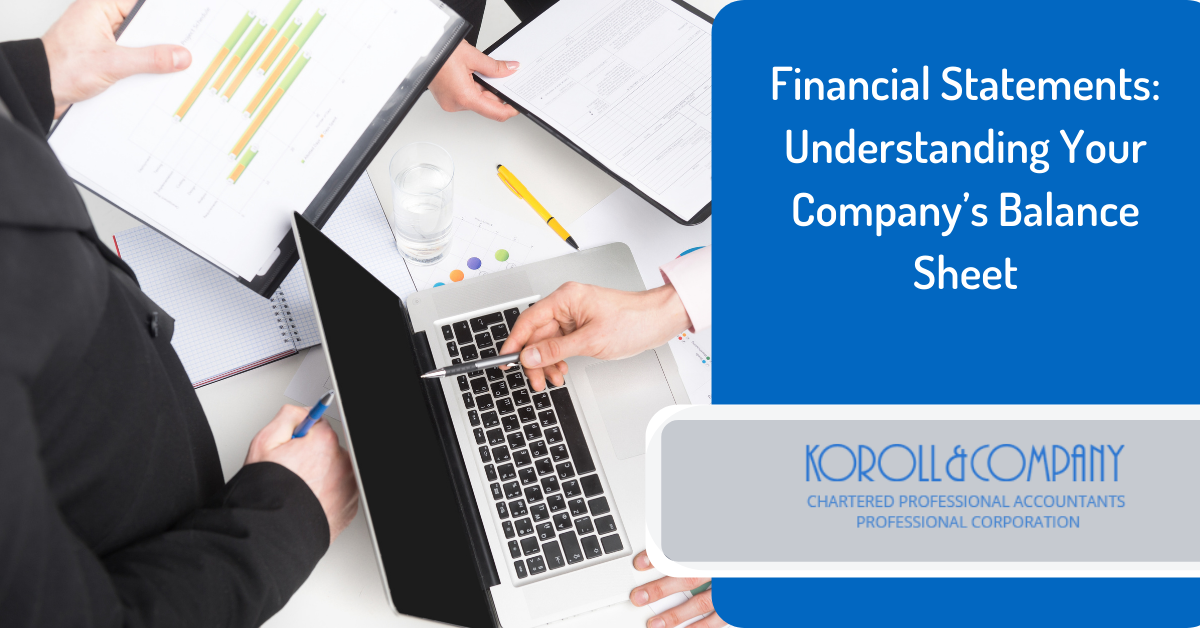 Your company’s balance sheet is one of your company’s major financial statements. It reports your business’s assets, liabilities and equity at a specified time – usually at the end of a month, quarter or year. It is a snapshot of what you owe and own.
Your company’s balance sheet is one of your company’s major financial statements. It reports your business’s assets, liabilities and equity at a specified time – usually at the end of a month, quarter or year. It is a snapshot of what you owe and own.
You can use this statement to see how much you have put into the business and how much debt you have accumulated. You can also use it to compare current assets and liabilities to ensure you can meet debt obligations each month.
Need help? Contact Koroll for Business Advisory services today.
Investors use this statement to calculate the rate of return and key ratios, such as the debt-to-equity ratio and current ratio. It also helps them evaluate your company’s capital structure. When compared to previous periods, investors will be able to see trends that will help with their investment decisions.
There are three main components of the balance sheet:
- Assets
These are items of value that you own. This includes current assets, such as cash, prepaid expenses, inventory, account receivable, which can be converted into cash within the year. It also includes long term or fixed assets, such as equipment, vehicles and real estate, that provide benefit to a company for more than a year.
On the balance sheet, assets are organized by those with high liquidity (current assets that can be easily converted to cash) to those with low liquidity. As such, you will usually see assets listed in this order:
- Cash (amount in bank, in petty cash, etc).
- Cash equivalents (treasury bills and short-term certificates of deposit).
- Marketable securities with a liquid market.
- Accounts receivable.
- Inventory.
- Prepaid expenses.
- Securities that can not be liquidated within 12 months.
- Fixed assets (machinery, buildings, land, etc).
- Intangible assets (goodwill, intellectual property, etc).
- Liabilities
These are financial debts and obligations. This includes current liabilities that are payable within a year, such as money owing to suppliers and tax payable. Long-term liabilities are payable over a longer period of time, such as mortgages, pension, etc.
Your listing of liabilities will be organized similar to assets, in that current liabilities that come due within a year are listed first, followed by the long term liabilities. Your liability listing will include:
- Current portion of long-term debts
- Credit card debt
- Interest payable
- Wages payable
- Accounts payable
- Long-term debt
- Pension fund liability
- Deferred tax liability
- Equity
Money/assets invested in the company by the owners/shareholders. This may be referred to shareholder equity or owner equity and is equal to assets less liabilities. When a business sells, the equity is paid out to the owners/shareholders.
This section of the balance sheet will often be broken down by:
- Retained earnings – net earnings that are being saved to reinvest into the company.
- Treasury stocks – stock that has been purchased back from shareholders.
- Common/Preferred Stock – ownership interest in the company by investors.
- Capital – amount shareholders have invested in the company.
- Drawings – money that the shareholders have taken out of the business (this will show as a negative amount in the equity section). Withdrawals related to sole proprietorships and partnerships and dividends are applicable to corporations.
When looking at your balance sheet, assets will be listed on the right and liabilities and equity will be listed on the left.
|
ASSETS |
|
|
LIABILITIES |
|
|
Bank account |
$7,000 |
|
Accounts payable |
$1,000 |
|
Account receivables |
$2,000 |
|
Long-term debt |
$4,000 |
|
Inventory |
$4,000 |
|
Total Liabilities |
$5,000 |
|
Equipment |
$1,000 |
|
|
|
|
Total Assets |
$14,000 |
|
EQUITY |
|
|
|
|
|
Capital |
$6,000 |
|
|
|
|
Retained earnings |
$4,000 |
|
|
|
|
Withdrawals |
($1,000) |
|
|
|
|
Total Equity |
$9,000 |
|
|
|
|
Total Liabilities and Shareholder Equity |
$14,000 |
The total of each side will be the same (i.e. Assets = Liabilities + Equity). This is because the assets you own are paid for by either taking on liabilities (borrowing money) or by investors by issuing additional equity.
The information found in a balance sheet is critical for determining whether a business is struggling or succeeding. Learning how to understand this statement and how others use it is critical. For help with your balance sheets, please contact us today.






